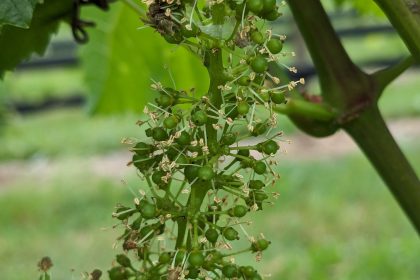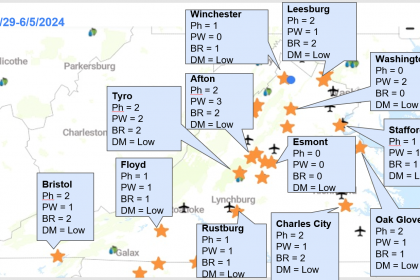I’m at a conference until 8/11. In the mean time, we will have a vineyard meeting at Winchester AREC on 8/5. I cannot attend, of course, but I prepared a note (click here to view) and Tony will go over it.
Since I may not able to update this blog, I summarized the disease risk at this point. I hope it will be helpful.
Disease risks at this point (early August)
The critical period for black rot, powdery mildew, and downy mildew fruit infection should be over (4-5 weeks after bloom).
Black Rot: Berries should not susceptible any longer.
- For the next year, make sure to remove all berries from your trellis at or after harvest. These infected berries can produce spores all season long if they are left on the trellis
- Phomopsis: Berries are susceptible all the time.
- Since we had such a long period of rain in the spring, you may see some berry infections. Usually, the damage done by Phomopsis is not significant, but if you have reasons to be afraid of Phomopsis, captan can be applied to protect berries.
Downy Mildew and Powdery mildew: Berries should not susceptible any longer.
- At this point, your focus is shifted to management of foliar health for accumulation of sugar to berries (for wine quality) and to trunk (for winter survival)
- Thus, periodical application of fungicide for downy and powder mildew is necessary; however, you do not need to have an intensive schedule as you may do during the critical time. 10 to 14-day interval should be enough to keep vines healthy unless there are many rain events.
- Fixed copper is a relatively inexpensive materials that can control both downy and powdery mildew. However, application within 30 days before harvest may decrease the quality of juice for wine making.
- Other materials to consider, especially within 30 days of harvest, are Potassium salt materials for powdery and Phosphorus acid materials and captan for downy mildew. Pristine can be used up to 14 days prior to harvest too. Please keep your eyes on PHI.
Botrytis: It favors humidity as well: canopy management is important.
- It is good at take an advantage of wounds. Successful insect management, such as against grape berry moth, helps reduce risk of Botrytis outbreak.
- There is no formal study done yet, but a combined application of fungicide at just before bunch closing plus at veraison is known to reduce the risk of Botrytis outbreak. Dead grape tissues (flowers, aborted berries) can be a medium for Botrytis, thus, good penetration of spray materials to inside of the bunch is important (an application prior to bunch closing), and the number of Botrytis spores in the air is high around veraison (an application around veraison).
Other late season rot:
- As with Botrytis, wounded berries can be susceptible to other microorganisms that cause “sour rot” or “bitter rot”.
- Thus, if you experience damage to berries due to hail, strong thunderstorms, excess moisture etc, you may need to react to the situation. Captan or Captan + Botrytis material is often recommended.
- When Brix is high (>20 or more), it is very difficult to control growth of microbes.
Other notes about chemical management
- Mancozeb products (Penncozeb, Dithane, etc) have a 66-day Pre-Harvest Interval.
- Sulfur applied under high temperature condition (> 85F) can cause damages on vines.
- Do not mix sulfur (or captan) with oil. It can burn grape tissues. Some insecticide formulations contain oil as a carrier!!





